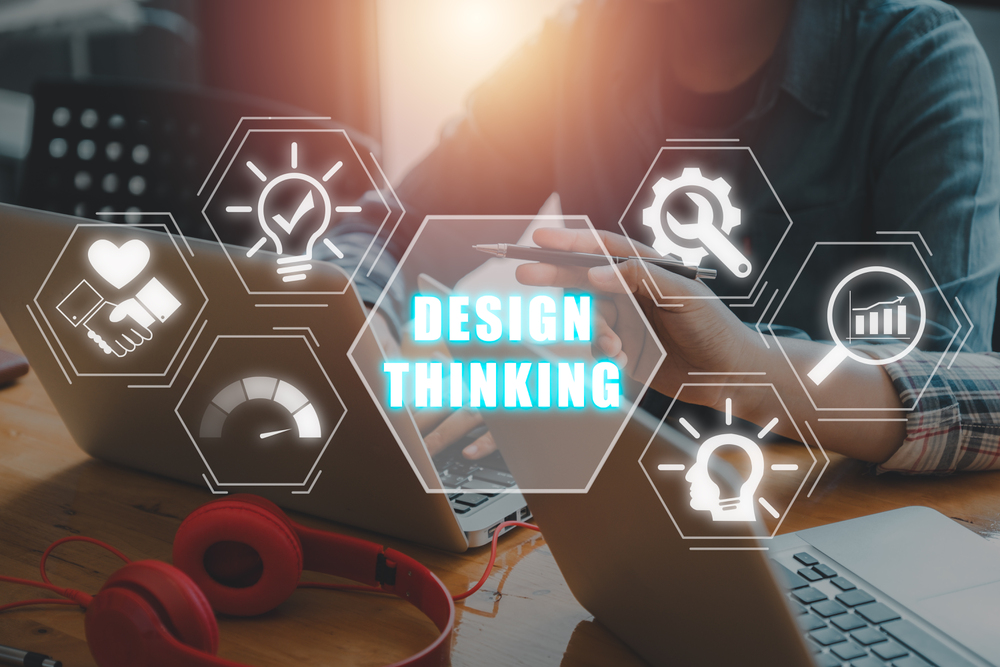
Is product design a human problem or a technology problem? You would probably argue that it is both. Product design, at its best, combines the efficiencies and automations of technology with human-centric thinking and intuition.
When designing products that incorporate generative AI, it may feel that you are tipping in the direction of being too technology-focused. You might be tempted to forego human intuition in order to develop products that embrace AI’s innovation. Or, you may have a more difficult time discerning what is meant to be human and what is meant to be purely technical, because AI is such a new and dynamic field that changes almost weekly.
The human/machine duality is precisely why combining human-centric Design Thinking with the power of Generative AI is so effective for product development.
Design Thinking isn’t merely a method; it’s a mindset focusing on user needs, iterative learning, and cross-functional teamwork—all of which are essential for pioneering AI-driven products.
The empathy at the heart of Design Thinking
Harvard Business School defines Design Thinking as “a mindset and approach to problem-solving and innovation anchored around human-centered design. It is different from other innovation and ideation processes in that it’s solution-based and user-centric rather than problem-based. This means it focuses on the solution to a problem instead of the problem itself.”
One might say that focusing on a solution to a problem, instead of the problem itself, is quite an empathetic way to approach a problem. Empathy, a cornerstone of Design Thinking, allows developers to understand their users deeply.
Design Thinking has five stages: Empathize, Define, Ideate, Prototype, and Test. The first stage, empathy, leads to algorithms that are not only robust, but also ethical and unbiased. Without empathy, AI has proven it can make decisions that are somewhat antagonistic to humans. The empathetic nature of Design Thinking ensures that, during the product development process, you create solutions that truly resonate with your end users.
Ideation, with AI
Ideation refers to the process of generating new ideas. Specifically in Design Thinking, it has been referred to as “the process of generating a broad set of ideas on a given topic, with no attempt to judge or evaluate them.”
Ideation means pushing beyond traditional algorithms to explore innovative AI applications. Similarly, prototyping with AI means developing minimal models to test hypotheses, refining functionalities based on user feedback, and minimizing costly errors down the line.
As you can see, the first three steps of Design Thinking can map directly back to responsible AI product development.
Continuous testing and learning
In Design Thinking, at the Testing stage, learning a continuous process. This always-learning mindset is particularly geared toward AI, which contains algorithms that improve over time as their machine learning models process and react to larger data sets, and refine their behavior accordingly.
As user interaction significantly impacts AI performance, ongoing testing helps product developers understand and adapt to diverse user behaviors and environments. Constant improvement and adaptation follows suit.
Applying the Six Thinking Hats to AI Development
Tangential to Design Thinking, Edward de Bono’s “Six Thinking Hats” method is another add-on for product development in the generative AI space. Each hat represents a unique perspective:
- White Hat: Focus on data and analysis
- Red Hat: Emphasize emotions and intuition
- Black Hat: Consider risks and challenges
- Yellow Hat: Highlight benefits and opportunities
- Green Hat: Encourage creativity and innovation
- Blue Hat: Manage the process and maintain organization
Imagine incorporating Generative AI as an additional “hat” in this process. AI can analyze data, generate fresh ideas, and predict potential issues, acting as a silent partner to enhance your brainstorming sessions.
The Benefits of Generative AI for Product Managers
Generative AI can be an invaluable asset for product managers, in the following ways:
- Brainstorming Assistant: Overcome creative blocks with AI-generated ideas
- Concept Refiner: Transform vague concepts into detailed prototypes
- Automation Tool: Handle mundane tasks, allowing focus on strategic elements
- Insight Generator: Extract hidden insights from vast data sets
Additionally, AI fosters cross-disciplinary collaboration, uniting experts, data scientists, UX/UI designers, product managers, and end-users to ensure well-rounded product development.
Ethical Considerations and the Role of AI
While AI is a powerful tool, it’s crucial to maintain ethical standards and monitor for biases. Generative AI should not be considered a replacement for human ethics and critical thinking. Instead, use it as a collaborative component for enhancing creativity and efficiency.
Design Thinking: Your signal in the noise
When lost in a sea of product development methodologies, let Design Thinking be your signal amidst the noise. This methodology elevates generative AI product development, because it makes the entire process more innovative and user-centric. Teams and companies adopting this approach are well-positioned to lead in technological advancements.

Jason Guarracino is a technical product lead at data.world. With over 28 years of experience in enterprise application development and technical product management, he has developed a deep expertise in Generative AI, Large Language Models (LLM), and Cloud Platforms. Jason currently leads the AI Context Engine, a technology that leverages knowledge graph and semantic web standards to deliver highly accurate and trustworthy AI-driven answers.



